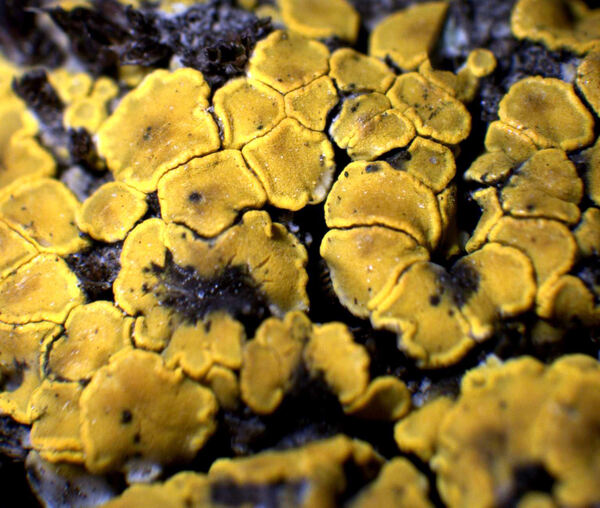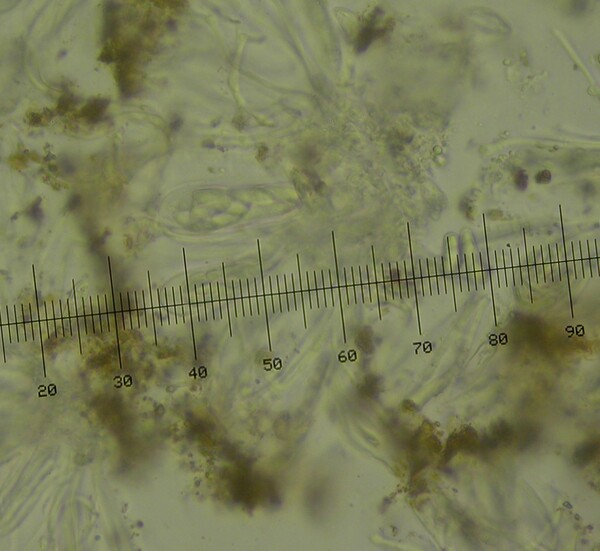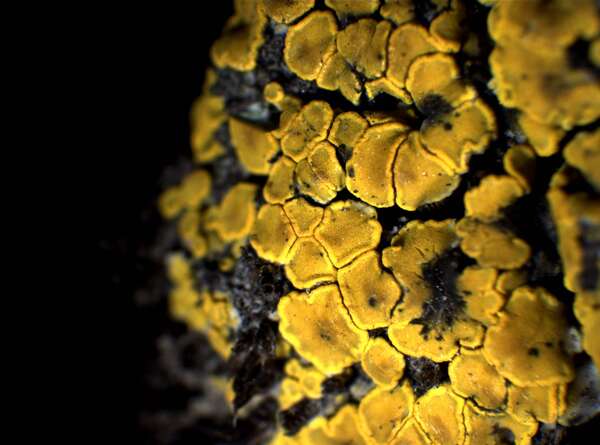Candelariella commutata Otte & M. Westb.
in Otte & al., Herzogia, 26: 218, 2013.
Synonyms: Candelariella unilocularis auct. ital. non (Elenkin) Nimis
Distribution: N - Frl, Ven (Nimis 1994), TAA (Nascimbene 2003b, 2008b, Nascimbene & al. 2004, 2004b, 2022), Lomb (Nascimbene 2006), Piem (TSB 34530). C - Umb (Nimis & Tretiach 1999, Ravera & al. 2006), Abr (Nimis & Tretiach 1999, Di Nuzzo & al. 2021, Gheza & al. 2021, Vallese & al. 2022), Mol (Nimis & Tretiach 2004, Caporale & al. 2008).
Description: Thallus crustose, yellow to yellow-orange, of scattered granules or small squamules, often reduced to the margin of apothecia. Apothecia lecanorine, sessile, round to irregular in outline, up to 2.5 mm across, with a yellow-pruinose, mostly flat disc and a thick, raised, persistent thalline margin. Proper exciple of elongated, thick-walled cells forming a compact layer below the hymenium; epithecium brownish yellow, covered in an epipsamma of minute crystals; hymenium colourless, c. 80 μm high, I+ blue; paraphyses simple or poorly branched, c. 2 μm wide, the tips not or only slightly swollen; hypothecium colourless. Asci 8-spored, clavate, with an apical dome which is I+ blue only in the internal, lower part, interrupted in the centre by an I+ paler blue strip, Candelaria-type. Ascospores 1-celled to rarely 1-septate, hyaline, oblong-obtuse, rounded at ends, straight or slightly curved, (18-)20-28(-32) x 5-6.5(-7.8) μm. Photobiont chlorococcoid. Spot tests: thallus K- or K+ weakly orange, C+ weakly orange, KC-, P-. Chemistry: thallus and apothecia with calycin, pulvinic acid and pulvinic dilactone. Note: I have placed here all records of C. unilocularis from Italy. This is an arctic-alpine species, widespread in the mountains of the southern holarctic zone; it is found on epilithic mosses on limestone and dolomite, a characteristic element of calcareous mountains, with optimum above treeline.
Growth form: Crustose
Substrata: soil, terricolous mosses, and plant debris
Photobiont: green algae other than Trentepohlia
Reproductive strategy: mainly sexual
Commonnes-rarity: (info)
Alpine belt: rather common
Subalpine belt: rather rare
Oromediterranean belt: very rare
Montane belt: absent
Submediterranean belt: absent
Padanian area: absent
Humid submediterranean belt: absent
Humid mediterranean belt: absent
Dry mediterranean belt: absent

Predictive model
Herbarium samples
Growth form: Crustose
Substrata: soil, terricolous mosses, and plant debris
Photobiont: green algae other than Trentepohlia
Reproductive strategy: mainly sexual
Commonnes-rarity: (info)
Alpine belt: rather common
Subalpine belt: rather rare
Oromediterranean belt: very rare
Montane belt: absent
Submediterranean belt: absent
Padanian area: absent
Humid submediterranean belt: absent
Humid mediterranean belt: absent
Dry mediterranean belt: absent

Predictive model
| Herbarium samples |
 INDEX FUNGORUM
INDEX FUNGORUM
 GBIF
GBIF
 DOLICHENS
DOLICHENS









